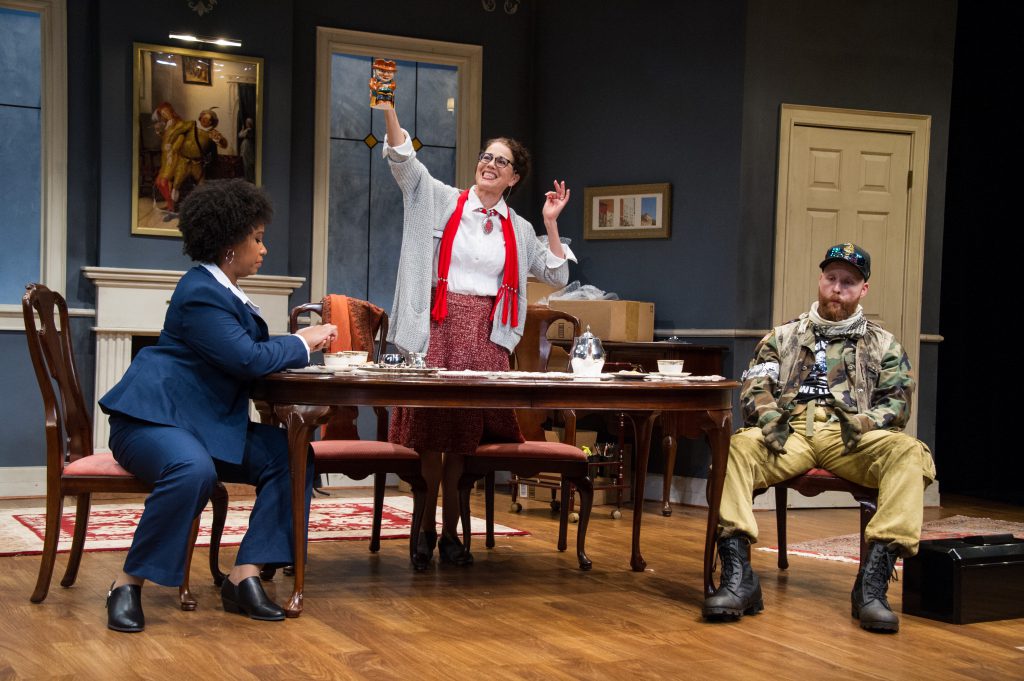Political satire of UrbanArias’ “Last American Hammer” misses the mark

(from left) Briana Elyse Hunter, Elizabeth Futral and Timothy Mix in UrbanArias’ “The Last American Hammer.” Photo: C. Stanley.
The small opera company UrbanArias takes risks, betting on unknown contemporary works and presenting them in smart, streamed-down productions. The gambit often pays dividends in Washington, where recent operas rarely see the light of day.
This weekend the company returned to the collaboration of composer Peter Hilliard and librettist Matt Boresi, for the world premiere of The Last American Hammer, heard Sunday afternoon at the Atlas Performing Arts Center.
In a small town in rural Ohio, a man named Milcom Negley makes a veiled threat to a woman who runs a museum devoted to obscure kitsch. The museum director, Tink Enraught, does not take the threat all that seriously, but a novice FBI agent, DeeDee Reyes, shows up to hear the man’s beef. He spews out a wild-eyed conspiracy theory about how most of the U.S. Constitution is illegitimate. While Milcom claims to be upset about the closure of the local hammer factory, he regularly refers to Asians, Mexicans, and other foreigners as the cause of America’s problems.
Timothy Mix, a baritone known from appearances with Washington National Opera, brought boundless energy and vocal strength to the role of the conspiracy theorist. He ranted, raged, roared, and raved, spittle flying, somehow managing to make his unhinged character sympathetic.
The highest vocal marks went to the velvety mezzo-soprano Briana Elyse Hunter. As the level-headed FBI agent—seemingly the only rational person in the opera—hers was a powerful but also subtle portrayal.
As the eccentric museum owner, who turns out to have her own secrets, Elizabeth Futral’s once-sparkling soprano sounded thin with an occasionally wobbly vibrato. She was often overpowered by the other cast members and the small chamber orchestra in the Paul Sprenger Theatre.
Artistic director Robert Wood competently led seven members of the Inscape Chamber Orchestra in realizing Hilliard’s score. The musical style is infused with country and folk music elements, not least in prominent parts for mandolin and banjo that added considerable appeal. A quintet of strings did most of the heavy lifting, ranging from percussive rhythm to lilting legato. Themes in pentatonic scales reinforced the sense of nostalgia that permeates the speeches of both the museum director and her unbalanced visitor, for an America that seems to be disappearing before their eyes.
Grant Preisser’s direction guided the singers into effective physical portrayals, the movements of the three characters reinforcing their attitudes. His set design consists of a few props portraying the small museum, including a table and display cases showing a collection of Toby Jugs, provided by the actual American Toby Jug Museum in Evanston, Illinois.
Still, this was the least successful of this composer-librettist team’s operas presented by UrbanArias in the last several years, following upon The Filthy Habit in 2012 and especially the appealing Blue Viola in 2015. Boresi’s dialogue is snappy and charming, although the unfolding of the story’s exposition seemed to take about twice as long as the material warranted.
While the work garnered laughs here and there, the current political climate makes such topical parodies a dicey matter. Conspiracy theories, as several recent events have shown, can have tragic and all too real consequences.
The Last American Hammer runs through September 29. urbanarias.org; 202-399-7993
